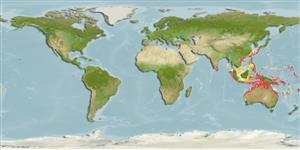Common names from other countries
>
Gobiiformes (Gobies) >
Gobiidae (Gobies) > Gobiinae
Etymology: Lubricogobius: Latin, lubricus = slipperiness, smoothness + Latin, gobius = gudgeon (Ref. 45335).
Environment: milieu / climate zone / depth range / distribution range
Οικολογία
Θαλασσινό(ά) βενθικό(ς); εύρος βάθους 17 - 79 m (Ref. 45340). Subtropical
Κατανομή
Χώρες | Περιοχές FAO | Οικοσυστήματα | Παρουσίες | Point map | Εισαγωγές | Faunafri
Indo-West Pacific: Japan (Ryukyu Islands), Vietnam, Indonesia (northern Sulawesi), Australia (Western Australia to Queensland) and New Caledonia.
Μέγεθος / Βάρος / Age
Maturity: Lm ? range ? - ? cm
Max length : 3.4 cm SL αρσενικό/απροσδιόριστο; (Ref. 45340)
Short description
Κλείδες προσδιορισμού | Μορφολογία | Μορφομετρία
Ραχιαίες άκανθες (συνολικά) : 7; Μαλακές ραχιαίες ακτίνες (συνολικά) : 8 - 10; Εδρικές άκανθες: 1; Μαλακές εδρικές ακτίνες: 6 - 7. Anterior nostrils present; dorsal and ventral edges of caudal peduncle not keeled; orange with pale blue lines radiating from eye and one descending from nape, bifurcating onto preopercular margin and opercle (Ref. 45340). Caudal fin rounded (Ref. 45340); further characterized by having united pelvic fins with well-developed frenum; absence of scales on head or body; no sensory pores on head, prominent papillae; depth of body 2.9-3.9 in SL (Ref. 90102).
Inhabits sand, silt, and rubble bottoms, takes refuge in dead shells, worn tubes, tunicates and empty bottles (Ref. 90102).
Life cycle and mating behavior
Maturities | Αναπαραγωγή | Spawnings | Egg(s) | Fecundities | Προνύμφες
Randall, J.E. and H. Senou, 2001. Review of the Indo-Pacific gobiid fish genus Lubricogobius, with description of a new species and a new genus for L. pumilus. Ichthyol. Res. 48(1):3-12. (Ref. 45340)
IUCN Red List Status (Ref. 130435)
CITES (Ref. 128078)
Not Evaluated
Threat to humans
Harmless
Human uses
Εργαλεία
Special reports
Download XML
Διαδικτυακές πηγές
Estimates based on models
Preferred temperature (Ref.
115969): 23.6 - 28.5, mean 27.2 (based on 219 cells).
Phylogenetic diversity index (Ref.
82804): PD
50 = 0.5156 [Uniqueness, from 0.5 = low to 2.0 = high].
Bayesian length-weight: a=0.01023 (0.00477 - 0.02194), b=3.02 (2.84 - 3.20), in cm Total Length, based on LWR estimates for this (Sub)family-body shape (Ref.
93245).
Τροφικό Επίπεδο (Ref.
69278): 3.1 ±0.3 se; based on size and trophs of closest relatives
Ελαστικότητα (Ref.
120179): Υψηλό, ελάχιστος χρόνος για διπλασιασμό πληθυσμού < 15 μήνες (Preliminary K or Fecundity.).
Fishing Vulnerability (Ref.
59153): Low vulnerability (10 of 100).
